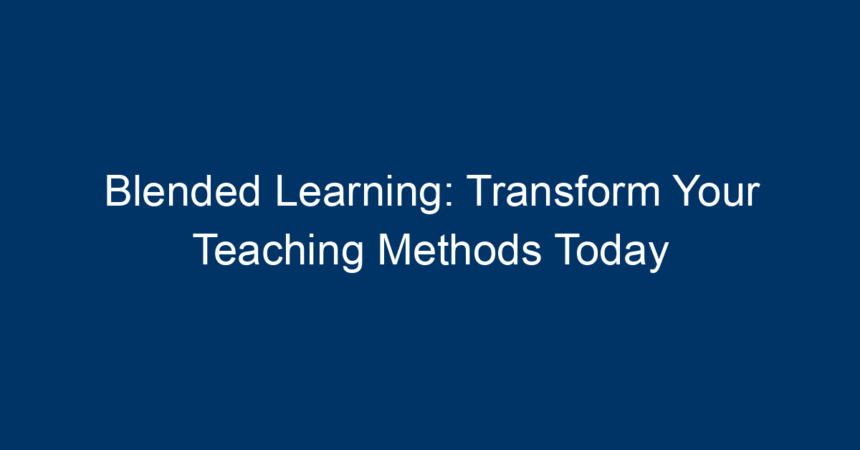In the evolving landscape of education, blended learning has emerged as a transformative approach that combines traditional face-to-face instruction with online learning. This innovative method not only enhances student engagement but also allows educators to personalize learning experiences. Whether you’re an experienced educator or new to the classroom, embracing blended learning can elevate your teaching methods and significantly improve student outcomes.
What is Blended Learning?
Blended learning integrates various instructional methods, allowing learners to interact with both digital content and physical classroom environments. This approach typically involves a mix of:
- Online Learning: This includes e-learning modules, video lectures, discussion forums, and online assessments.
- In-Person Instruction: Traditional classes where teachers and students interact directly.
The goal is to create a more personalized learning environment that meets the diverse needs of students while utilizing technology to enhance learning experiences.
The Benefits of Blended Learning
Implementing blended learning can yield numerous benefits for both students and educators. Understanding these advantages can inspire you to transform your teaching methods:
1. Enhanced Flexibility
Blended learning offers students the flexibility to learn at their own pace. They can review recorded lectures, participate in online discussions, and complete assignments according to their individual schedules. This flexibility caters to different learning styles and can help students grasp complex subjects more effectively.
2. Increased Engagement
By incorporating multimedia resources such as videos, interactive quizzes, and gamified elements, blended learning captures students’ attention in ways that traditional teaching methods may not. This engaging approach fosters a stimulating learning environment where students are motivated to participate actively.
3. Personalized Learning
Blended learning allows educators to tailor their teaching strategies based on individual student needs. With tools like learning management systems (LMS), teachers can track student progress and provide personalized feedback. This customization helps address knowledge gaps and challenges, leading to a more effective learning experience.
4. Improved Learning Outcomes
Research shows that students engaged in blended learning often perform better academically compared to those in traditional settings. The combination of various instructional methods can enhance retention and understanding, contributing to superior learning outcomes.
5. Preparation for the Future
In an increasingly digital world, incorporating blended learning prepares students for future academic and professional environments. Familiarity with online tools and resources equips them with the necessary skills for today’s job market, which increasingly values technology literacy.
Implementing Blended Learning: Key Strategies
To successfully adopt blended learning in your teaching approach, consider the following strategies:
1. Assess Your Goals and Resources
Before diving into blended learning, evaluate your teaching goals and the resources available. Ask yourself:
- What are the objectives you want to achieve with blended learning?
- What technology is available to you and your students?
Understanding these elements will help you create a tailored plan for implementation.
2. Choose the Right Technology
Selecting suitable technological tools is crucial for a successful blended learning experience. Consider:
- Learning Management Systems (LMS): Platforms like Google Classroom, Moodle, or Canvas facilitate course management, communication, and resource sharing.
- Interactive Tools: Look for applications that promote collaboration, such as Padlet, Nearpod, or Kahoot! to engage students in real-time.
3. Design Engaging Content
Create content that combines multimedia elements such as videos, infographics, and interactive activities. Aim to make lessons visually appealing and intellectually stimulating to maintain student interest.
4. Foster Community and Collaboration
Building a strong learning community is essential in a blended learning environment. Encourage collaboration by having students participate in group projects or discussions, both online and offline. This communal approach enhances peer learning and creates a supportive environment.
5. Provide Ongoing Support
Transitioning to a blended learning model can be challenging for both educators and students. Provide ongoing support and resources to help everyone adapt to the new system. Regular check-ins, workshops, and feedback sessions can ease the transition and promote continuous improvement.
6. Evaluate and Iterate
After implementing blended learning, continuously assess its effectiveness. Gather feedback from students and adjust your strategies accordingly. By being flexible and open to change, you can enhance the blended learning experience over time.
Overcoming Challenges in Blended Learning
Despite the numerous advantages of blended learning, implementing this approach can present several challenges. Here’s how to tackle common obstacles:
1. Technology Access
Not all students may have equal access to technology. To counter this, consider providing alternative resources, such as downloadable content, or offer access to school facilities where students can use technology.
2. Time Management
Educators might struggle to balance traditional teaching and online resources. To manage time effectively, plan your lessons meticulously and establish a clear schedule for both in-person and online components.
3. Resistance to Change
Some students may resist this shift toward blended learning. It’s vital to communicate the benefits of this approach and provide support to ease their concerns. Foster an open dialogue and involve them in the transition process to increase buy-in.
Conclusion: Embrace the Future of Education with Blended Learning
Blended learning represents a revolutionary way to engage students and enhance learning outcomes. By embracing this modern approach, educators can make teaching more effective and personalized while preparing students for success in a digital world.
Actionable Insights:
- Start by assessing your current teaching methods and determine how blended learning can be integrated.
- Select appropriate technology and design engaging content that fits your teaching style.
- Foster a supportive learning environment through collaboration and community building.
- Be open to feedback and continuously evolve your approach to maximize the benefits of blended learning.
Transform your teaching methods today, and watch your students thrive in an enriched learning environment that blends the best of both worlds!




